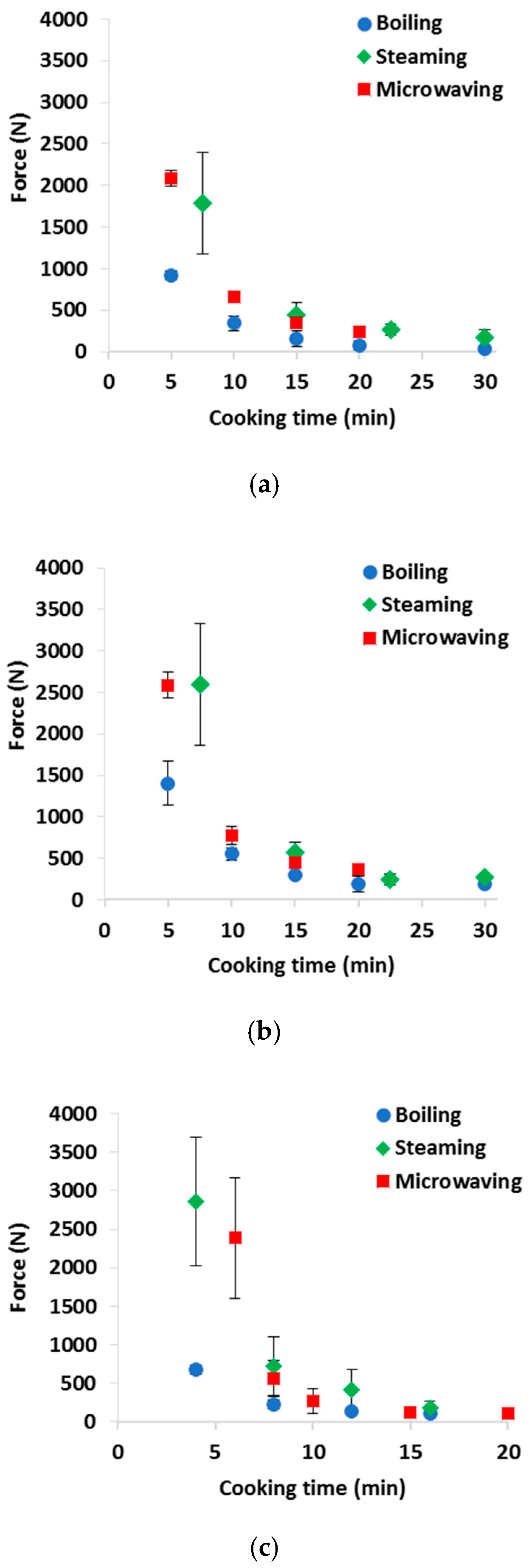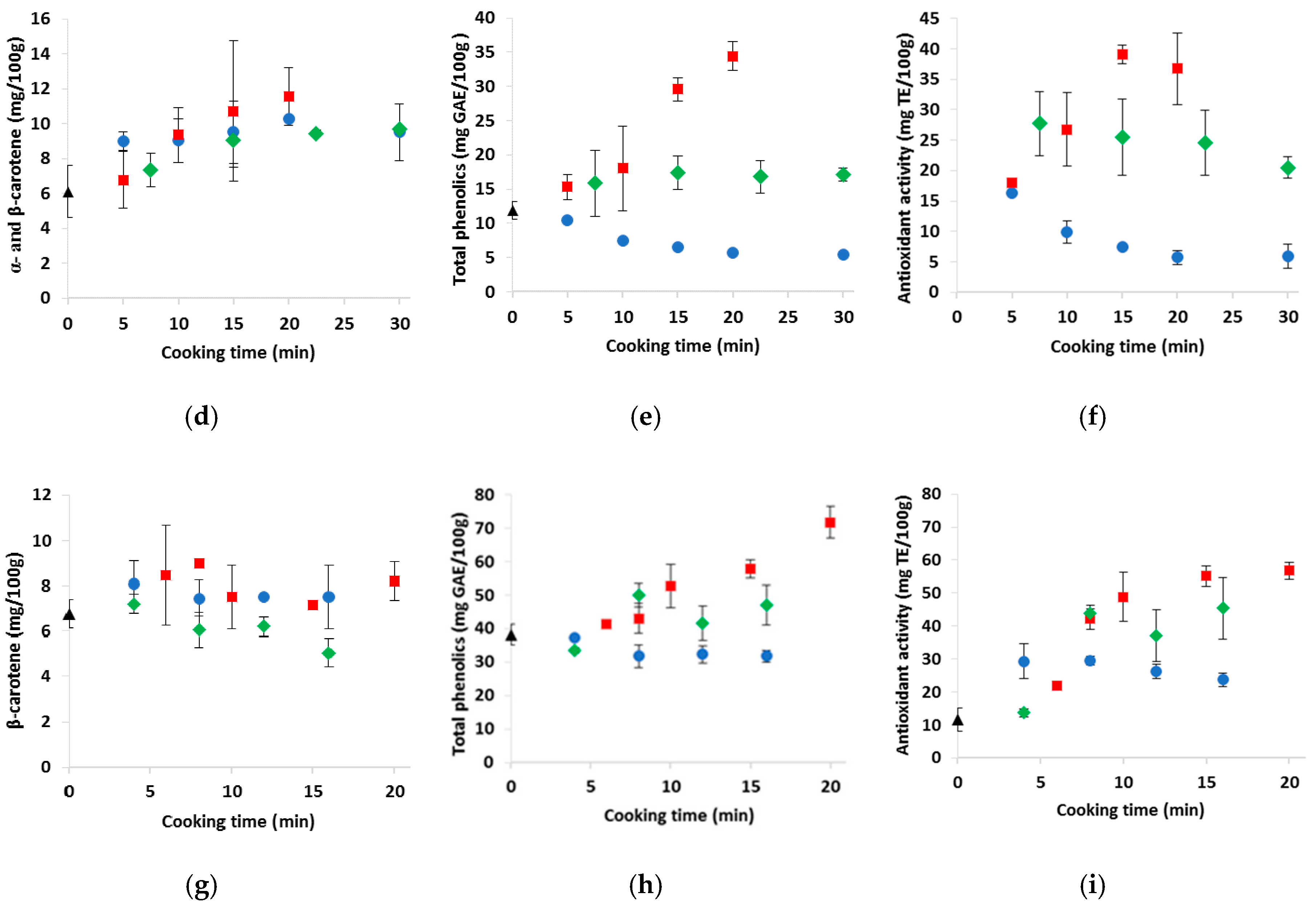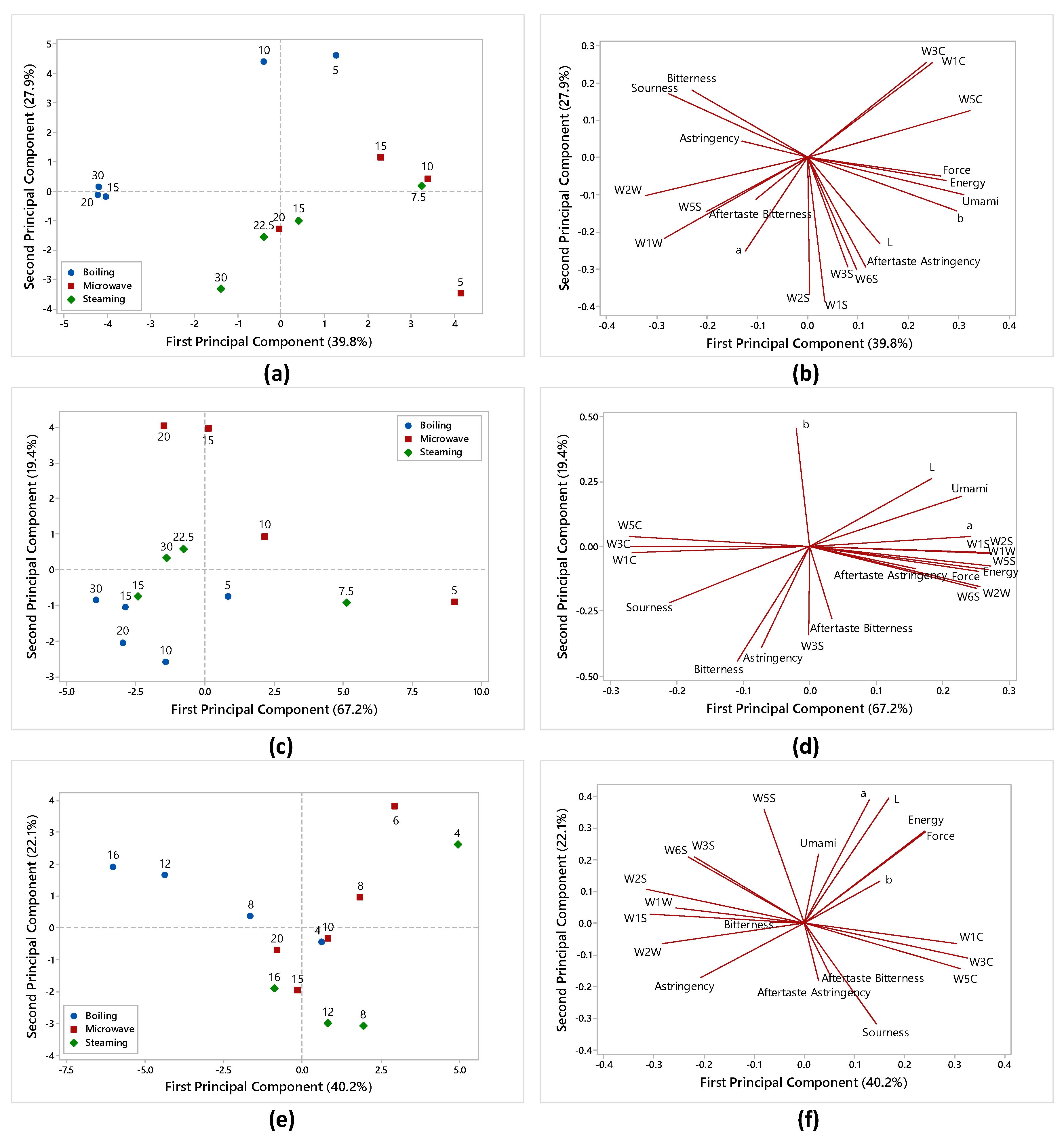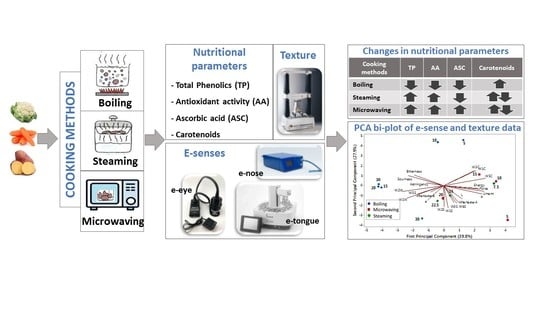Influence of Cooking Conditions on Nutritional Properties and Sensory Characteristics Interpreted by E-Senses: Case-Study on Selected Vegetables
Abstract
1. Introduction
2. Materials and Methods
2.1. Raw Vegetables
2.2. Cooking Conditions
2.3. Texture
2.4. Analytical Determinations
2.5. Electronic Nose
2.6. Electronic Tongue
2.7. Electronic Eye
2.8. Statistics
3. Results and Discussion
3.1. Texture
3.2. Nutritional Properties
3.2.1. Cauliflowers
3.2.2. Carrots
3.2.3. Sweet Potatoes
3.3. E-senses Results
4. Conclusions
Author Contributions
Funding
Acknowledgments
Conflicts of Interest
References
- Kiran, K.S.; Padmaja, G. Inactivation of trypsin inhibitors in sweet potato and taro tubers during processing. Plant Food Hum. Nutr. 2003, 58, 153–163. [Google Scholar] [CrossRef] [PubMed]
- Gupta, K.; Wagle, D.S. Nutritional and antinutritional factors of green leafy vegetables. J. Agr. Food Chem. 1988, 36, 472–474. [Google Scholar] [CrossRef]
- Turkmen, N.; Sari, F.; Velioglu, Y.S. The effect of cooking methods on total phenolics and antioxidant activity of selected green vegetables. Food Chem. 2005, 93, 713–718. [Google Scholar] [CrossRef]
- Bengtsson, A.; Larsson Alminger, M.; Svanberg, U. In vitro bioaccessibility of β-carotene from heat-processed orange-fleshed sweet potato. J. Agr. Food Chem. 2009, 57, 9693–9698. [Google Scholar] [CrossRef] [PubMed]
- Rock, C.L.; Lovalvo, J.L.; Emenhiser, C.; Ruffin, M.T.; Flatt, S.W.; Schwartz, S.J. Bioavailability of β-carotene is lower in raw than in processed carrots and spinach in women. J. Nutr. 1998, 128, 913–916. [Google Scholar] [CrossRef] [PubMed]
- Guillén, S.; Mir-Bel, J.; Oria, R.; Salvador, M.L. Influence of cooking conditions on organoleptic and health-related properties of artichokes, green beans, broccoli and carrots. Food Chem. 2017, 217, 209–216. [Google Scholar] [CrossRef]
- Nicoletto, C.; Vianello, F.; Sambo, P. Effect of different home-cooking methods on textural and nutritional properties of sweet potato genotypes grown in temperate climate conditions. J. Sci. Food Agric. 2018, 98, 574–581. [Google Scholar] [CrossRef]
- Rennie, C.; Wise, A. Preferences for steaming of vegetables. J. Hum. Nutr. Diet. 2010, 23, 108–110. [Google Scholar] [CrossRef]
- Chuah, A.M.; Lee, Y.C.; Yamaguchi, T.; Takamura, H.; Yin, L.J.; Matoba, T. Effect of cooking on the antioxidant properties of coloured peppers. Food Chem. 2008, 111, 20–28. [Google Scholar] [CrossRef]
- Palermo, M.; Pellegrini, N.; Fogliano, V. The effect of cooking on the phytochemical content of vegetables. J. Sci. Food Agric. 2014, 94, 1057–1070. [Google Scholar] [CrossRef]
- Bongoni, R.; Verkerk, R.; Steenbekkers, B.; Dekker, M.; Stieger, M. Evaluation of different cooking conditions on broccoli (Brassica oleracea var. italica) to improve the nutritional value and consumer acceptance. Plant Foods Hum. Nutr. 2014, 69, 228–234. [Google Scholar] [CrossRef] [PubMed]
- Bongoni, R.; Stieger, M.; Dekker, M.; Steenbekkers, B.; Verkerk, R. Sensory and health properties of steamed and boiled carrots (Daucus carota ssp. sativus). Int. J. Food Sci. Nutr. 2014, 65, 809–815. [Google Scholar] [CrossRef] [PubMed]
- Bongoni, R. Consumers and Vegetables: Effects of Domestic Processing on Sensory and Health Properties; Wageningen University: Wageningen, The Netherlands, 2014; p. 151. [Google Scholar]
- Kala, A.; Prakash, J. The comparative evaluation of the nutrient composition and sensory attributes of four vegetables cooked by different methods. Int. J. Food Sci. Technol. 2006, 41, 163–171. [Google Scholar] [CrossRef]
- Sliwinska, M.; Wisniewska, P.; Dymerski, T.; Namiesnik, J.; Wardencki, W. Food analysis using artificial senses. J. Agric. Food Chem. 2014, 62, 1423–1448. [Google Scholar] [CrossRef] [PubMed]
- Ouyang, Q.; Zhao, J.; Chen, Q. Instrumental intelligent test of food sensory quality as mimic of human panel test combining multiple cross-perception sensors and data fusion. Anal. Chim. Acta 2014, 841, 68–76. [Google Scholar] [CrossRef] [PubMed]
- AOAC. Official Methods of Analysis, 12th ed.; Association of Official Analytical Chemists: Arlington, VA, USA, 2002. [Google Scholar]
- Singleton, V.L.; Rossi, J.A. Colorimetry of total phenolics with phosphomolybdic–phosphotungstic acid reagents. Am. J. Enol. Viticult. 1965, 16, 144–158. [Google Scholar]
- Buratti, S.; Benedetti, S.; Giovanelli, G. Application of electronic senses to characterize espresso coffees brewed with different thermal profiles. Eur. Food Res. Technol. 2017, 243, 511–520. [Google Scholar] [CrossRef]
- Brand-Williams, W.; Cuvelier, M.E.; Berset, C. Use of a free radical method to evaluate antioxidant activity. LWT-Food Sci. Technol. 1995, 28, 25–30. [Google Scholar] [CrossRef]
- Giovanelli, G.; Limbo, S.; Buratti, S. Effects of new packaging solutions on physico-chemical, nutritional and aromatic characteristics of red raspberries (Rubus idaeus L.) in postharvest storage. Postharvest Biol. Technol. 2014, 98, 72–81. [Google Scholar] [CrossRef]
- Kobayashi, Y.; Habara, M.; Ikezazki, H.; Chen, R.; Naito, Y.; Toko, K. Advanced taste sensors based on artificial lipids with global selectivity to basic taste qualities and high correlation to sensory scores. Sensors 2010, 10, 3411–3443. [Google Scholar] [CrossRef]
- Wold, S.; Esbensen, K.; Geladi, P. Principle component analysis. Chemom. Intell. Lab. Syst. 1987, 2, 37–52. [Google Scholar] [CrossRef]
- Mazzeo, T.; N’Dri, D.; Chiavaro, E.; Visconti, A.; Fogliano, V.; Pellegrini, N. Effect of two cooking procedures on phytochemical compounds, total antioxidant capacity and color of selected frozen vegetables. Food Chem. 2011, 128, 627–633. [Google Scholar] [CrossRef]
- Vallejo, F.; Tomas-Barberan, F.A.; Garcia-Viguera, C. Glucosinolates and vitamin C content in edible parts of broccoli florets after domestic cooking. Eur. Food Res. Technol. 2002, 215, 310–316. [Google Scholar]
- Podsedek, A. Natural antioxidants and antioxidant capacity of Brassica vegetables: A review. LWT—Food Sci. Technol. 2007, 40, 1–11. [Google Scholar] [CrossRef]
- Volden, J.; Borge, G.I.A.; Hansen, M.; Wicklund, T.; Bengtsson, G. Processing (blanching, boiling, steaming) effects on the content of glucosinolates and antioxidant-related parameters in cauliflower (Brassica oleracea L. ssp. botyris). LWT-Food Sci. Technol. 2009, 42, 63–73. [Google Scholar] [CrossRef]
- Pellegrini, N.; Chiavaro, E.; Gardana, C.; Mazzeo, T.; Contino, D.; Gallo, M.; Riso, P.; Fogliano, V.; Porrini, M. Effect of Different Cooking Methods on Color, Phytochemical Concentration, and Antioxidant Capacity fo Raw and Frozen Brassica Vegetables. J. Agric. Food Chem. 2010, 58, 4310–4321. [Google Scholar] [CrossRef]
- Miglio, C.; Chiavaro, E.; Visconti, A.; Fogliano, V.; Pellegrini, N. Effect of different cooking methods on nutritional and physicochemical characteristics of selected vegetables. J. Agric. Food Chem. 2008, 56, 139–147. [Google Scholar] [CrossRef]
- Bureau, S.; Mouhoubi, S.; Touloumet, L.; Garcia, C.; Moreau, F.; Bedouet, V.; Renard, C.M.G.C. Are folates, carotenoids and vitamin C affected by cooking? Four domestic procedures are compared on a large diversity of frozen vegetables. LWT—Food Sci. Technol. 2015, 64, 735–741. [Google Scholar] [CrossRef]
- Proteggente, A.R.; Pannala, A.S.; Paganga, G.; Van Buren, L.; Wagner, E.; Wiseman, S.; van de put, F.; Dacombe, C.; Rice-Evans, C.A. The antioxidant activity of regularly consumed fruit and vegetables reflects their phenolic and vitamin C composition. Free Radic. Res. 2002, 36, 2017–2233. [Google Scholar] [CrossRef]
- Natella, F.; Belelli, F.; Ramberti, A.; Scaccini, C. Microwave and traditional cooking methods: Effect of cooking on antioxidant capacity and phenolic compounds content on seven vegetables. J. Food Biochem. 2010, 34, 796–810. [Google Scholar] [CrossRef]
- Podsedek, A.; Sosnowska, D.; Redzynia, M.; Koziolkiewicz, M. Effect of domestic cooking on the red cabbage hydrophilic antioxidants. Int. J. Food Sci. Technol. 2008, 43, 1770–1777. [Google Scholar] [CrossRef]
- Lemmens, L.; Van Buggenhout, S.; Oey, I.; Van Loey, A.; Hendrickx, M. Towards a better understanding of the relationship between the β-carotene in vitro bio-accessibility and pectin structural changes: A case study on carrots. Food Res. Int. 2009, 42, 1323–1330. [Google Scholar] [CrossRef]
- Faller, A.L.K.; Fialho, E. The antioxidant capacity and polyphenol content of organic and conventional retail vegetables after domestic cooking. Food Res. Int. 2009, 42, 210–215. [Google Scholar] [CrossRef]
- Wang, S.; Nie, S.; Zhu, F. Chemical constituents and health effects of sweet potato. Food Res. Int. 2016, 89, 90–116. [Google Scholar] [CrossRef] [PubMed]
- Chen, Y.; Xu, Y.; Cao, Y.; Fang, K.; Xia, F.; Jiang, Q. Combined effect of microwave and steam cooking on phytochemical compounds and antioxidant activity of purple sweet potatoes. Food Sci. Technol. Res. 2017, 23, 193–201. [Google Scholar] [CrossRef]
- Food Composition Database for Epidemiological Studies in Italy (Banca Dati di Composizione degli Alimenti per Studi Epidemiologici in Italia—BDA). European Institute of Oncology. 2015. Available online: http://www.bda-ieo.it/wordpress/en/ (accessed on 14 January 2020).
- Bengtsson, A.; Namutebi, A.; Larsson Alminger, M.; Svangberg, U. Effects of various traditional processing methods on the all-trans-β-carotene content of orange-fleshed sweet potato. J. Food Compos. Anal. 2008, 21, 134–143. [Google Scholar] [CrossRef]
- Donado-Pestana, C.M.; Mastrodi Salgado, J.; de Oliveira Rios, A.; dos Santos, P.R.; Jablonsky, A. Stability of carotenoids, total phenolics and in vitro antioxidant capacity in the thermal processing of orange-fleshed sweet potato (Ipomea batatas Lam.) cultivars grown in Brazil. Plant Foods Hum. Nutr. 2012, 67, 262–270. [Google Scholar] [CrossRef]
- Kuan, L.Y.; Thoo, Y.Y.; Siow, L.F. Bioactive components, ABTS radical scavenging capacity and physical stability of orange, yellow and purple sweet potato (Ipomea batatas) powder processed by convection- or vacuum-drying methods. Int. J. Food Sci. Technol. 2016, 51, 700–709. [Google Scholar] [CrossRef]
- Dincer, C.; Karaoglan, M.; Erden, F.; Tetik, N.; Topuz, A.; Ozdemir, F. Effects of baking and boiling on the nutritional and antioxidant properties of sweet potato [Ipomoea batatas (L.) Lam.] cultivars. Plant Foods Hum. Nutr. 2011, 66, 341–347. [Google Scholar] [CrossRef]
- Wang, Y.; Kays, S.J. Effect of cooking method on the aroma constituents of sweet potatoes [Ipomoea batatas (L.) Lam.]. J. Food Qual. 2001, 24, 67–78. [Google Scholar] [CrossRef]




| Cooking System and Time (min) | Solids (g/100 g) | Ascorbic Acid (mg/100 g dw) | Total Phenolics (mg GAE/100 g dw) | Antioxidant Activity (mg TE/100 g dw) | ||||
|---|---|---|---|---|---|---|---|---|
| Trial 1 | Trial 2 | Trial 1 | Trial 2 | Trial 1 | Trial 2 | Trial 1 | Trial 2 | |
| Boiling | ||||||||
| Raw (t0) | 7.9 ± 0.1f | 7.6 ± 0.1b | nd | nd | 403 ± 18d | 500 ± 15e | 41 ± 17a | 72 ± 22a |
| 5 | 6.8 ± 0.1e | 7.2 ± 0.1b | 550 ± 6d | 467 ± 9c | 490 ± 27e | 403 ± 13d | 866 ± 16bc | 855 ± 28c |
| 10 | 6.2 ± 0.1d | 6.8 ± 0.4b | 461 ± 6c | 388 ± 16b | 420 ± 29d | 369 ± 8c | 1376 ± 140d | 1185 ± 27d |
| 15 | 5.9 ± 0.1c | 6.7 ± 0.3b | 315 ± 1b | 241 ± 8a | 339 ± 17c | 316 ± 1a | 1005 ± 165c | 868 ± 30c |
| 20 | 5.5 ± 0.1b | 5.2 ± 0.8a | 213 ± 1a | 266 ± 45a | 293 ± 21b | 337 ± 10b | 793 ± 40b | 745 ± 43b |
| 30 | 5.2 ± 0.1a | 4.5 ± 0.3a | 222 ± 3a | 236 ± 17a | 248 ± 7a | 391 ± 14d | 797 ± 29b | 885 ± 11c |
| p-value | *** | ** | *** | *** | *** | *** | *** | *** |
| Steaming | ||||||||
| Raw (t0) | 8.6 ± 0.1b | 9.0 ± 0.7abc | nd | nd | 348 ± 6a | 394 ± 20a | 52 ± 23a | 35 ± 2a |
| Blanching | - | - | 588 ± 45c | 405 ± 7b | - | - | - | - |
| 7.5 | 8.5 ± 0.1b | 8.8 ± 0.1a | 397 ± 11b | 441 ± 47b | 507 ± 5b | 558 ± 7c | 748 ± 24c | 704 ± 25b |
| 15 | 8.7 ± 0.1b | 9.1 ± 0.2bc | 386 ± 18b | 345 ± 33a | 492 ± 20b | 573 ± 7cd | 556 ± 15b | 904 ± 22d |
| 22.5 | 8.4 ± 0.1ab | 8.8 ± 0.1ab | 399 ± 2b | 307 ± 11a | 509 ± 8b | 586 ± 8d | 850 ± 34d | 879 ± 108cd |
| 30 | 8.2 ± 0.2a | 9.3 ± 0.1c | 334 ± 9a | 261 ± 7a | 621 ± 15c | 452 ± 6b | 1184 ± 35e | 807 ± 50c |
| p-value | * | * | * | * | *** | *** | *** | *** |
| Microwaving | ||||||||
| Raw (t0) | 8.5 ± 0.6a | 8.0 ± 0.7a | nd | nd | 390 ± 43a | 413 ± 8a | 94 ± 17a | 104 ± 15a |
| Blanching | - | - | 472 ± 32c | 404 ± 33a | - | - | - | - |
| 5 | 9.3 ± 0.1b | 9.1 ± 0.1b | 340 ± 20a | 439 ± 12b | 358 ± 6a | 524 ± 7b | 251 ± 34b | 255 ± 15b |
| 10 | 12 ± 0.1c | 9.6 ± 0.1c | 420 ± 6b | 487 ± 4c | 532 ± 18b | 571 ± 12c | 1021 ± 43d | 547 ± 26c |
| 15 | 12 ± 0.2d | 11 ± 0.3e | 367 ± 10ab | 426 ± 9ab | 574 ± 10c | 625 ± 6d | 800 ± 11c | 905 ± 17e |
| 20 | 15 ± 0.1e | 10 ± 0.1d | 425 ± 39b | 411 ± 4a | 616 ± 19d | 640 ± 7e | 1032 ± 4d | 821 ± 20d |
| p-value | *** | *** | * | ** | *** | *** | *** | *** |
| Cooking System and Time (min) | Solids (g/100 g) | β-Carotene (mg/100 g dw) | α-Carotene (mg/100 g dw) | Total Phenolics (mg GAE/100 g dw) | Antioxidant Activity (mg TE/100 g dw) | |||||
|---|---|---|---|---|---|---|---|---|---|---|
| Trial 1 | Trial 2 | Trial 1 | Trial 2 | Trial 1 | Trial 2 | Trial 1 | Trial 2 | Trial 1 | Trial 2 | |
| Boiling | ||||||||||
| Raw (t0) | 9.7 ± 0.1e | 10.3 ± 0.6d | 37 ± 2a | 27 ± 6a | 24 ± 6a | 21 ± 9a | 140 ± 30c | 121 ± 11d | nd | nd |
| 5 | 8.2 ± 0.1d | 8.2 ± 0.1c | 67 ± 12b | 65 ± 3b | 41 ± 7b | 48 ± 3b | 132 ± 10c | 124 ± 4d | 202 ± 9b | 198 ± 4d |
| 10 | 6.9 ± 0.1c | 6.7 ± 0b | 69 ± 2b | 87 ± 4c | 49 ± 0bc | 60 ± 3c | 109 ± 2b | 108 ± 3c | 126 ± 4a | 166 ± 5c |
| 15 | 5.9 ± 0.1b | 6.5 ± 0.1b | 81 ± 6bc | 97 ± 2d | 60 ± 6c | 65 ± 5cd | 108 ± 1ab | 102 ± 5b | 131 ± 6a | 110 ± 8b |
| 20 | 5.0 ± 0.2a | 5.8 ± 0.2a | 125 ± 8d | 107 ± 2e | 79 ± 7d | 70 ± 1de | 114 ± 3b | 97 ± 4b | 130 ± 1a | 85 ± 20a |
| 30 | 5.8 ± 0.1b | 5.8 ± 0.7a | 86 ± 2c | 109 ± 6e | 59 ± 0c | 74 ± 1e | 99 ± 7a | 88 ± 3a | 125 ± 5a | 77 ± 12a |
| p-value | *** | *** | *** | *** | *** | *** | *** | *** | *** | *** |
| Steaming | ||||||||||
| Raw (t0) | 9.7 ± 0.1b | 10.3 ± 0.6b | 27 ± 2a | 42 ± 6a | 21 ± 6a | 32 ± 9a | 124 ± 30a | 107 ± 11a | nd | nd |
| 7.5 | 10.6 ± 0.1e | 10.1 ± 0.1b | 39 ± 13a | 37 ± 2a | 30 ± 11ab | 29 ± 3a | 202 ± 4d | 102 ± 3a | 297 ± 10b | 183 ± 8a |
| 15 | 10.2 ± 0.1d | 8.0 ± 1.7a | 57 ± 5b | 60 ± 2b | 43 ± 1b | 39 ± 1b | 187 ± 13c | 196 ± 18c | 292 ± 24b | 264 ± 3d |
| 22.5 | 9.4 ± 0.1a | 9.2 ± 0.1ab | 59 ± 1b | 61 ± 1b | 42 ± 0b | 41 ± 1b | 197 ± 9cd | 163 ± 17b | 302 ± 6b | 225 ± 4c |
| 30 | 10.0 ± 0.1c | 9.3 ± 0.1ab | 57 ± 1b | 63 ± 0b | 40 ± 2b | 42 ± 1b | 164 ± 6b | 192 ± 7c | 218 ± 3a | 208 ± 2b |
| p-value | *** | * | * | *** | * | ** | *** | *** | *** | *** |
| Microwaving | ||||||||||
| Raw (t0) | 9.7 ± 0.1a | 10.6 ± 0.6a | 37 ± 2 | 42 ± 6ab | 24 ± 6a | 32 ± 9ab | 140 ± 30a | 108 ± 11a | nd | nd |
| 5 | 10.2 ± 0.1b | 11.0 ± 0.1b | 40 ± 5 | 38 ± 4a | 24 ± 3a | 26 ± 4a | 163 ± 3b | 128 ± 6b | 177 ± 7a | 164 ± 2a |
| 10 | 12.4 ± 0.1c | 10.6 ± 0.1a | 44 ± 2 | 49 ± 3bc | 32 ± 2b | 38 ± 2b | 181 ± 4c | 128 ± 3b | 275 ± 4c | 182 ± 2b |
| 15 | 14.4 ± 0.1d | 15.3 ± 0.3c | 33 ± 11 | 54 ± 1c | 20 ± 5a | 36 ± 0b | 196 ± 9d | 202 ± 10d | 278 ± 4c | 249 ± 8c |
| 20 | 17 ± 0.3e | 17.4 ± 0.3d | 41 ± 2 | 40 ± 2a | 25 ± 1a | 29 ± 2a | 211 ± 8e | 189 ± 8c | 241 ± 2b | 187 ± 3b |
| p-value | *** | *** | ns | * | * | * | *** | *** | *** | *** |
| Cooking System and Time (min) | Solids (g/100 g) | β-caroTene (mg/100 g dw) | Total Phenolics (mg GAE/100 g dw) | Antioxidant Activity (mg TE/100 g dw) | ||||
|---|---|---|---|---|---|---|---|---|
| Trial 1 | Trial 2 | Trial 1 | Trial 2 | Trial 1 | Trial 2 | Trial 1 | Trial 2 | |
| Boiling | ||||||||
| Raw (t0) | 19.2 ± 0.2d | 18.3 ± 0.2d | 33 ± 2a | 39 ± 4 | 187 ± 4a | 210 ± 9cd | 48 ± 3a | 73 ± 8a |
| 4 | 16.2 ± 0.1c | 17.2 ± 0.1c | 46 ± 4b | 51 ± 3 | 229 ± 9c | 217 ± 8d | 204 ± 4c | 149 ± 13b |
| 8 | 15.4 ± 0.1b | 15.8 ± 0.2b | 45 ± 8b | 51 ± 5 | 222 ± 2bc | 185 ± 8a | 198 ± 2c | 180 ± 8c |
| 12 | 16.1 ± 0.1c | 15.9 ± 0.1b | 47 ± 4b | 47 ± 2 | 212 ± 11b | 192 ± 12ab | 154 ± 6b | 175 ± 6c |
| 16 | 14.8 ± 0.1a | 15.1 ± 0.2a | 44 ± 1b | 46 ± 4 | 223 ± 9bc | 202 ± 8bc | 150 ± 5b | 167 ± 17c |
| p value | *** | *** | * | ns | *** | *** | *** | *** |
| Steaming | ||||||||
| Raw (t0) | 19.2 ± 0.2c | 18.3 ± 0.2d | 33 ± 2ab | 39 ± 4 | 187 ± 4a | 210 ± 9b | 48 ± 3a | 73 ± 8a |
| 4 | 17.9 ± 0.1b | 17.9 ± 0.2c | 42 ± 2c | 38 ± 0 | 183 ± 12a | 190 ± 5a | 81 ± 17b | 72 ± 1a |
| 8 | 17.0 ± 0.2a | 17.9 ± 0.1c | 32 ± 5ab | 37 ± 1 | 309 ± 7c | 265 ± 9c | 249 ± 6e | 249 ± 16b |
| 12 | 16.9 ± 0.1a | 15.8 ± 0.1a | 38 ± 0bc | 37 ± 7 | 225 ± 10b | 288 ± 7d | 187 ± 7c | 271 ± 12c |
| 16 | 17.9 ± 0.2b | 16.9 ± 0.1b | 26 ± 4a | 33 ± 2 | 240 ± 9b | 302 ± 6e | 217 ± 1d | 308 ± 3d |
| p value | *** | *** | * | ns | *** | *** | *** | *** |
| Microwaving | ||||||||
| Raw (t0) | 19.2 ± 0.2b | 18.3 ± 0.2a | 33 ± 2ab | 39 ± 4ab | 187 ± 4a | 210 ± 9a | 48 ± 3a | 73 ± 8a |
| 6 | 19.0 ± 0.1a | 19.0 ± 0.3b | 37 ± 2b | 53 ± 1c | 218 ± 3c | 215 ± 8a | 113 ± 6b | 117 ± 8b |
| 8 | 19.6 ± 0.1c | 19.2 ± 0.2b | 45 ± 1c | 47 ± 1bc | 204 ± 7b | 241 ± 7c | 227 ± 11c | 208 ± 7d |
| 10 | 19.9 ± 0.2d | 21.0 ± 0.1c | 33 ± 3ab | 41 ± 5b | 288 ± 9f | 229 ± 9b | 271 ± 6d | 208 ± 10d |
| 15 | 22.3 ± 0.1e | 23.4 ± 0.1d | 32 ± 4ab | 31 ± 4a | 250 ± 10d | 255 ± 7d | 257 ± 19d | 226 ± 16e |
| 20 | 25.0 ± 0.2f | 28.8 ± 0.3e | 26 ± 1a | 31 ± 1a | 273 ± 11e | 261 ± 5d | 234 ± 11c | 191 ± 12c |
| p value | *** | *** | ** | ** | *** | *** | *** | *** |
© 2020 by the authors. Licensee MDPI, Basel, Switzerland. This article is an open access article distributed under the terms and conditions of the Creative Commons Attribution (CC BY) license (http://creativecommons.org/licenses/by/4.0/).
Share and Cite
Buratti, S.; Cappa, C.; Benedetti, S.; Giovanelli, G. Influence of Cooking Conditions on Nutritional Properties and Sensory Characteristics Interpreted by E-Senses: Case-Study on Selected Vegetables. Foods 2020, 9, 607. https://doi.org/10.3390/foods9050607
Buratti S, Cappa C, Benedetti S, Giovanelli G. Influence of Cooking Conditions on Nutritional Properties and Sensory Characteristics Interpreted by E-Senses: Case-Study on Selected Vegetables. Foods. 2020; 9(5):607. https://doi.org/10.3390/foods9050607
Chicago/Turabian StyleBuratti, Susanna, Carola Cappa, Simona Benedetti, and Gabriella Giovanelli. 2020. "Influence of Cooking Conditions on Nutritional Properties and Sensory Characteristics Interpreted by E-Senses: Case-Study on Selected Vegetables" Foods 9, no. 5: 607. https://doi.org/10.3390/foods9050607
APA StyleBuratti, S., Cappa, C., Benedetti, S., & Giovanelli, G. (2020). Influence of Cooking Conditions on Nutritional Properties and Sensory Characteristics Interpreted by E-Senses: Case-Study on Selected Vegetables. Foods, 9(5), 607. https://doi.org/10.3390/foods9050607







